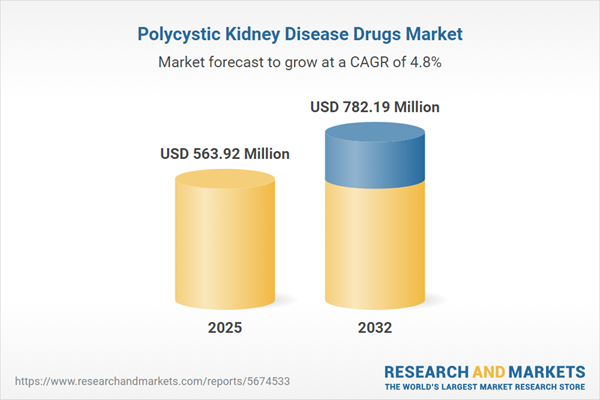Speak directly to the analyst to clarify any post sales queries you may have.
Senior executives seeking reliable insights into the polycystic kidney disease drugs market require focused intelligence that addresses shifting regulations, technological advancements, and evolving care standards. This analysis provides actionable guidance for leaders responsible for shaping resilient strategies in a transforming healthcare environment.
Market Snapshot: Polycystic Kidney Disease Drugs Market
The polycystic kidney disease drugs market is seeing steady growth, underpinned by strategic investment in emerging therapies and adaptive patient care models. This expansion results from ongoing therapeutic innovation, the worldwide increase in disease prevalence, and the growing adoption of patient-centric care solutions. As the market’s landscape evolves, stakeholders respond proactively to regulatory trends and operational demands, fostering both rapid adaptation and resilience. Companies able to deliver clinically validated treatments and maintain compliance with evolving standards are well positioned for sustained progress within this dynamic sector.
Scope & Segmentation: Executive Insights
This executive-focused framework enhances decision clarity across major market segments, regions, and technologies, empowering leaders to navigate partnerships, capital allocation, and market expansion with confidence. By providing transparent segmentation, this analysis assists organizations in anticipating changes and supporting agile responses to competitive and regulatory shifts.
- Drug Types: Angiotensin II receptor blockers, angiotensin-converting enzyme inhibitors, calcium channel blockers, mTOR inhibitors, somatostatin analogs, and vasopressin receptor antagonists support comprehensive portfolio strategies and tailored patient care pathways.
- Modes of Administration: Oral, injectable, and intravenous formulations allow flexibility in clinical delivery and help address patient adherence by offering convenience and adaptability.
- Disease Types: Targeted solutions for both autosomal dominant and autosomal recessive forms enable more customized therapeutic approaches and support individualized treatment pathways.
- Distribution Channels: Hospital, retail, and online pharmacies expand treatment accessibility and drive efficiency within pharmaceutical supply chains.
- End-Users: Clinics, hospitals, and homecare providers facilitate care continuity and support better patient outcomes from diagnosis through long-term disease management.
- Regions Covered: The market framework includes the Americas, Europe, Middle East, Africa, and Asia-Pacific, each with unique regulatory and commercial dynamics, information essential for targeted entry and sustained expansion.
- Company Coverage: Assessment encompasses leading organizations such as Apotex Inc., Boehringer Ingelheim GmbH, Centessa Pharmaceuticals Limited, Eli Lilly and Company, F. Hoffmann-La Roche AG, Fresenius Kabi AG, Galapagos NV, Kyowa Hakko Kirin Co., Ltd., Merck & Co., Inc., Mitsubishi Tanabe Pharma Corporation, Novartis International AG, Otsuka Pharmaceutical Co., Ltd., Pfizer Inc., Sanofi S.A., Teva Pharmaceutical Industries Ltd., Vertex Pharmaceuticals Incorporated, and Viatris Inc.
This comprehensive segmentation supports executives in streamlining compliance objectives, prioritizing technology investments, and reinforcing strategic resilience in diverse operational settings.
Key Takeaways for Senior Decision-Makers
- Partnering with established research organizations and public health bodies accelerates therapy development and extends treatment access for key patient groups.
- Digital health integration enhances workflow, strengthens coordinated care delivery, and improves efficiency across multiple clinical settings through remote monitoring and data exchange.
- Applying biomarker-driven clinical trial approaches refines patient stratification and expedites regulatory milestones for emerging therapies.
- Incorporating real-world data in payer and regulator negotiations reinforces value-based models and opens routes to improved reimbursement frameworks.
- Forming strategic alliances, such as licensing or co-development, diversifies risk and allows broader market access across different regions.
- Proactive attention to local and international regulatory shifts ensures ongoing compliance and supports swift adaptation to policy changes impacting market participation.
Tariff Impact: Navigating U.S. 2025 Changes
Forthcoming U.S. tariff modifications in 2025 prompt companies in the polycystic kidney disease drugs market to assess and refine their supply chain strategies. Initiatives including dual-source procurement, the creation of regional supply hubs, and near-shoring bolster supply continuity and address increased logistics costs. Ongoing collaboration with compliance and health economics specialists will be instrumental for meeting updated procurement standards and payer requirements in the evolving regulatory landscape.
Methodology & Data Sources
Report conclusions are drawn from peer-reviewed research, international regulatory materials, patent analyses, and feedback from subject matter leaders. This foundation supports strategic planning, robust risk identification, and comprehensive assessments of market opportunities for executive teams.
Why This Report Matters
- Delivers actionable, data-driven guidance for senior executives making focused investment and commercialization decisions in the polycystic kidney disease drugs sector.
- Equips organizations to respond effectively to operational and regulatory changes, supporting agile adaptation in international markets.
- Enables informed, timely responses to technological shifts and policy updates, reinforcing regulatory compliance and competitive positioning.
Conclusion
The polycystic kidney disease drugs market is advancing in response to shifts in science and regulation. Access to strategic, relevant intelligence equips leaders to steer growth and address emerging challenges across the healthcare landscape.
Additional Product Information:
- Purchase of this report includes 1 year online access with quarterly updates.
- This report can be updated on request. Please contact our Customer Experience team using the Ask a Question widget on our website.
Table of Contents
3. Executive Summary
4. Market Overview
7. Cumulative Impact of Artificial Intelligence 2025
Companies Mentioned
The companies profiled in this Polycystic Kidney Disease Drugs market report include:- Apotex Inc.
- Boehringer Ingelheim GmbH
- Centessa Pharmaceuticals Limited
- Eli Lilly and Company
- F. Hoffmann-La Roche AG
- Fresenius Kabi AG
- Galapagos NV
- Kyowa Hakko Kirin Co., Ltd.
- Merck & Co., Inc.
- Mitsubishi Tanabe Pharma Corporation
- Novartis International AG
- Otsuka Pharmaceutical Co., Ltd.
- Pfizer Inc.
- Sanofi S.A.
- Teva Pharmaceutical Industries Ltd.
- Vertex Pharmaceuticals Incorporated
- Viatris Inc.
Table Information
| Report Attribute | Details |
|---|---|
| No. of Pages | 187 |
| Published | November 2025 |
| Forecast Period | 2025 - 2032 |
| Estimated Market Value ( USD | $ 563.92 Million |
| Forecasted Market Value ( USD | $ 782.19 Million |
| Compound Annual Growth Rate | 4.7% |
| Regions Covered | Global |
| No. of Companies Mentioned | 18 |









